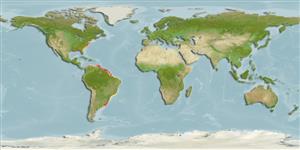Classification / Names
Noms communs | Synonymes | Catalog of Fishes(Genre, Espèce) | ITIS | CoL | WoRMS | Cloffa
>
Scombriformes (Mackerels) >
Stromateidae (Butterfishes)
Etymology: Peprilus: Greek, peprilos, paprax, certain fish from Tracia.
Environment: milieu / climate zone / depth range / distribution range
Écologie
marin; saumâtre; profondeur 13 - 136 m (Ref. 116249). Tropical
Western Atlantic: French Guiana and Argentina
Taille / Poids / Âge
Maturity: Lm ? range ? - ? cm
Max length : 22.0 cm TL mâle / non sexé; (Ref. 124480); poids max. publié: 66.80 g (Ref. 118626)
Description synthétique
Morphologie | Morphométrie
Épines dorsales (Total): 3 - 5; Rayons mous dorsaux (Total): 39-45; Épines anales 3-4; Rayons mous anaux: 36 - 41; Vertèbres: 28 - 29. This species is distinguished from its congeners (except P. xanthurus) by having the following characters: precaudal vertebrae 11?12 (vs. 13 or more, rarely 12); total vertebrae 28?29 (vs. 30 or more in P. medius, P. ovatus, P. simillimus and P. snyderi); body height 58.5?79.0% SL (vs. 33.0?52.% SL in P. burti, P. simillimus, P. snyderi, P. ovatus and P. triacanthus); without series of pores along the front half of body under the dorsal fin (vs. 17?25 in P. triacanthus); a moderately falcate dorsal fin (vs. not falcate in P. triacanthus, or conspicuously falcate in P. paru); specimens larger than 9.0 cm SL, has an extremely falcate anal fin (vs. not falcate or moderately falcate in P. burti, P. simillimus, P. snyderi, P. ovatus and P. triacanthus); further distinguished from sympatric P. xanthurus by the lack of a conspicuous dark spot over the eyes, from snout to nape (vs. a conspicuous dark spot over the eyes, especially distinct in fresh specimens); in specimens smaller than 11.0 cm SL, orbital diameter is 1.6?5.0 in anal-fin height (vs. 5.1?8.0); in specimens larger than 10.9 cm SL, orbital diameter is 3.2?5.2 in anal-fin height (vs. 5.5?9.2), 2.9?3.8 in pectoral-fin height (vs. 3.9?5.9), and 0.8?1.4 in post-orbital length (vs. 1.5?2.3); further distinguished from P. paru by having a moderately long to short dorsal fin and relatively long caudal fin lobe, with length of lower lobe more than 1.2 times the length of the dorsal fin (vs. 1.2 times the length or less) (Ref. 116249).
Occurs in estuarine and coastal marine waters at depths of up to 136 meters. Probably does not form large schools for though it is common in the catches of artisanal fisheries (notably in Brazil), it is always in small numbers (Ref. 116249).
Life cycle and mating behavior
Maturité | Reproduction | Frai | Œufs | Fécondité | Larves
Marceniuk, A.P., R. Caires and R. Siccha-Ramirez, 2016. Review of the harvestfishes, genus Peprilus (Perciformes: Stromateidae), of the Atlantic coast of South America. Zootaxa 4098(2):311-332. (Ref. 116249)
Statut dans la liste rouge de l'IUCN (Ref. 130435)
Menace pour l'homme
Harmless
Utilisations par l'homme
Plus d'informations
PaysZones FAOÉcosystèmesOccurrencesIntroductionsStocksÉcologieRégime alimentaireÉléments du régime alimentaireConsommation alimentaireRation
Noms communsSynonymesMétabolismePrédateursÉcotoxicologieReproductionMaturitéFraiRassemblement de ponteFéconditéŒufsDéveloppement de l'œuf
RéférencesAquacultureProfil d'aquacultureSouchesGénétiqueElectrophoresesHéritabilitéPathologiesTraitementNutrientsMass conversion
CollaborateursImagesStamps, Coins Misc.SonsCiguateraVitesseType de nageSurface branchialeOtolithesCerveauxVision
Outils
Articles particuliers
Télécharger en XML
Sources Internet
Estimates based on models
Phylogenetic diversity index (Ref.
82804): PD
50 = 0.5020 [Uniqueness, from 0.5 = low to 2.0 = high].
Bayesian length-weight: a=0.01622 (0.00965 - 0.02725), b=2.93 (2.79 - 3.07), in cm total length, based on LWR estimates for this species & Genus-body shape (Ref.
93245).
Niveau trophique (Ref.
69278): 3.9 ±0.2 se; based on size and trophs of closest relatives
Résilience (Ref.
120179): Haut, temps minimum de doublement de population inférieur à 15 mois (Preliminary K or Fecundity.).
Fishing Vulnerability (Ref.
59153): Low vulnerability (12 of 100).
